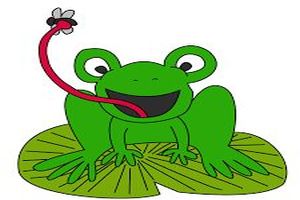With a hop and a jump
Have you heard frogs croaking in the rain? Even in our built-up cities, you can find frogs if you have a small garden. Frogs belong to the category of animals known as amphibians. This means that they can live on land and in water.
Given that there are over 5000 frog species, it is not surprising their eating habits also vary. Frogs can be insectivores (insect-eaters) or carnivores (meat-eaters). The insects they consume include flies, mosquitoes, worms and grasshoppers. The bigger frogs can devour mice, small snakes, other frogs and even baby turtles. Here’s another interesting fact about frogs: they absorb water through the skin; so they don’t need to drink like we do.

A frog catches its prey with its tongue, which is one-third the length of its body. Doesn’t seem like much to us humans, but for frogs that’s huge. To make it more useful, the tongue is attached to the front of the mouth and is sticky at the front. So the frog can just flip its tongue out and pick up its meal, which will stick to the adhesive part.
Now let’s look at the life cycle of a frog. Life cycle means the various changes a living creature goes through during its lifetime. Since these stages repeat for every new generation of that species, it’s called a life cycle.
Female frogs lay close to 4000 fertilized eggs in a water body. These eggs stick together in a clump and are coated with a jelly-like substance. So it’s not easy to handle these with bare hands. It takes around three weeks for them to hatch into tadpoles, which look like little fish.
Tadpoles live in water for several weeks and eat plants and algae. To help it survive in an aquatic environment, it has gills. After several weeks, these tadpoles develop into froglets. The lungs develop so that it can breathe when it moves to the land. The hind legs (back legs) also appear during this time. It starts jumping around as well. But it still has a long long tail. Over time, the tail shortens and the front legs start to appear. It stores nutrients in its tail and uses that for its growth.
Once it’s tail is just a tiny stub, it comes out of the water and onto land. This is the young frog. And it’s pretty small in size. Finally, once the tail disappears and it begins to eat insects, the frog is officially an adult. Which then lays eggs, if it is a female, and the cycle begins again.
Many species of frogs are declining due to various factors: pollution of water bodies, loss of habitats, threats from diseases, invasive species and climate change and over-harvesting for pets and food. So what? What use are these, you might wonder. Here is why it’s important to save frogs:
When they eat algae and water plants as tadpoles, they are helping regulate the aquatic flora. They also help filter the water in the waterbodies.
As predators, given the large quantities of insects they eat, especially mosquitoes, they help prevent transmission of infectious diseases like malaria.
As prey, they are an important food source for a range of animals such as fish, monkeys, snakes and birds.
Thus the declining number of frogs affects the intricate food web and also the larger ecosystem. Now that you’ve read about frogs, here’s an activity. Below are images of the frog’s life cycle. Put them in the right order.